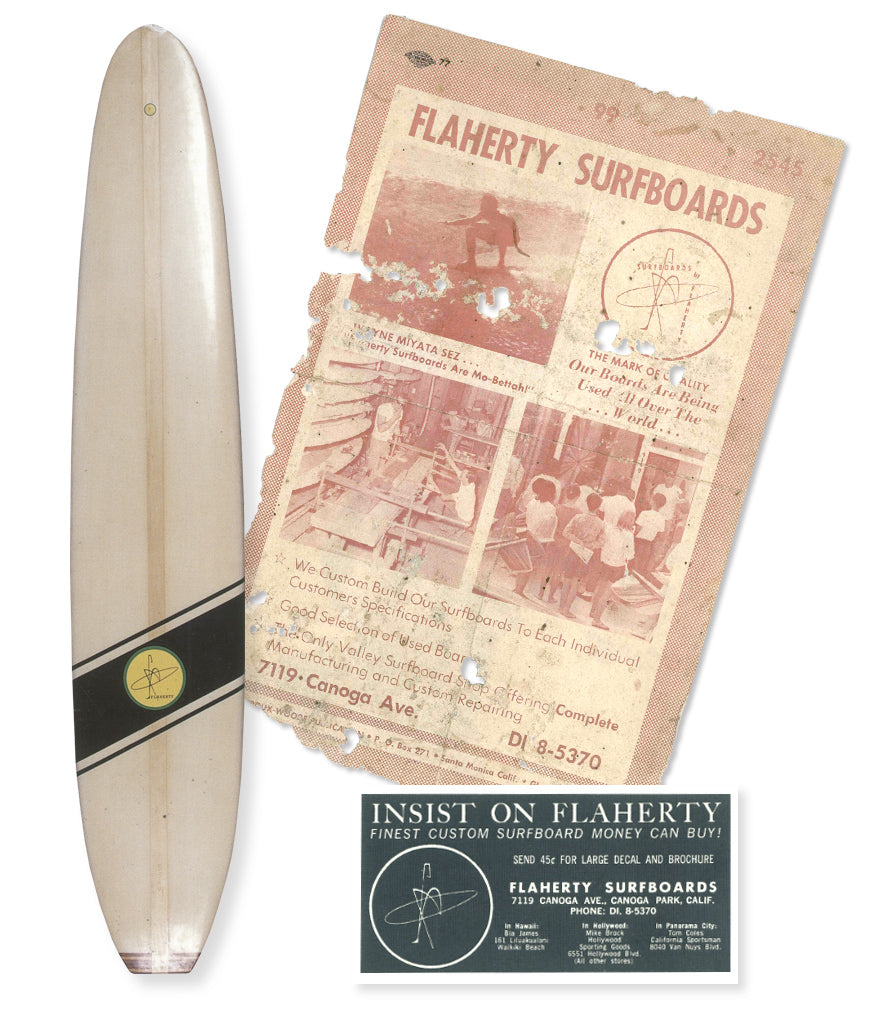Home
›
Iconic Brands: A retrospective
›
Flaherty Surfboards: A Legacy of Craftsmanship and Custom Surfboard Innovation

Flaherty Surfboards: A Legacy of Craftsmanship and Custom Surfboard Innovation
Few names evoke the sense of craftsmanship and dedication to quality quite like Flaherty Surfboards. Born in the 1950s and thriving through the '60s, Flaherty Surfboards became synonymous with custom-made boards designed to the specific needs of surfers who wanted not just a board, but a finely tuned instrument to navigate the waves. With their roots in Southern California and Hawaii, Flaherty Surfboards is remembered as a brand that helped push forward the evolution of surfboard design during a pivotal time in surf history.
A Custom Craft for Every Surfer
Founded by Bob Flaherty, the brand quickly garnered a reputation for its personalized approach to surfboard shaping. Unlike mass-produced boards, Flaherty took pride in creating custom boards tailored to each surfer’s height, weight, and preferred style of surfing. Whether someone was a casual rider or a competitive surfer, Flaherty understood the nuances that made a board perform optimally for the individual.
The company's slogan, "Finest Custom Surfboard Money Can Buy," wasn’t just marketing hype—it was a statement of dedication. Each Flaherty board was crafted by hand, with precision and passion, in the Canoga Park workshop on Canoga Avenue in California’s San Fernando Valley. Their meticulous attention to detail and use of high-quality materials made them a favorite among surfers in California and Hawaii.
The Impact of Innovation
Flaherty Surfboards rose to prominence during a time when surfboard technology was rapidly evolving. Traditional heavy wooden boards were being replaced by lighter balsa wood, and later, foam and fiberglass construction. Flaherty was at the forefront of these changes, adopting new materials and techniques to make boards faster, lighter, and more maneuverable. These innovations enabled surfers to ride bigger waves and execute more dynamic maneuvers, further pushing the boundaries of what was possible in the sport.
In addition to creating custom boards, Flaherty offered repair services and a selection of used boards, making it a hub for surfers of all levels. Their shop wasn’t just a place to pick up a board; it was a gathering spot for the local surf community to share stories, tips, and advice. The brand’s success wasn’t just in its product—it was in the community it fostered around the culture of surfing.
Hawaii and the Flaherty Connection
While Flaherty was based in California, the company had a strong presence in Hawaii, the spiritual home of surfing. Their reputation for producing high-performance boards spread across the islands, particularly on Oahu’s famous Waikiki Beach. Hawaiian surfers, known for their deep respect for the ocean and their pursuit of the perfect wave, trusted Flaherty’s craftsmanship to deliver the right tools for their art.
One of the key elements that attracted Hawaiian surfers to Flaherty was their respect for tradition combined with a forward-thinking approach. Surfers were able to rely on the durability and precision of Flaherty boards in challenging Hawaiian surf conditions, where waves could be both powerful and unpredictable. The connection between Flaherty Surfboards and Hawaii is a testament to how deeply intertwined the brand became with the broader surf culture across both coasts.
A Legacy That Endures
Though Flaherty Surfboards may not have the same commercial recognition today as some larger surf brands, its impact on the surfing world endures. The meticulous attention to detail and personal approach to shaping boards left a lasting impression on those who rode them. Vintage Flaherty boards are now considered collector’s items, cherished by surf enthusiasts who appreciate the history and craftsmanship behind each board.
At Malibu Shirts, we are proud to celebrate the rich history of surfing and the iconic brands that have shaped its culture. Flaherty Surfboards, with its focus on custom designs and craftsmanship, represents the spirit of innovation and individuality that defines surfing’s golden era. Our vintage-inspired designs honor the legacy of surf pioneers like Bob Flaherty, whose passion for the sport helped push it to new heights.
Share



